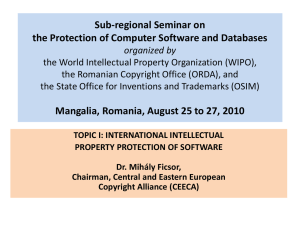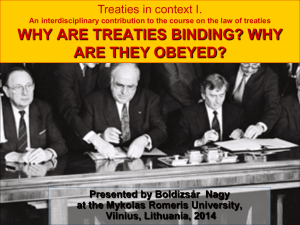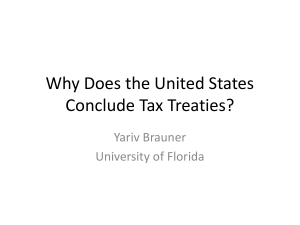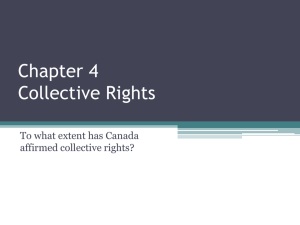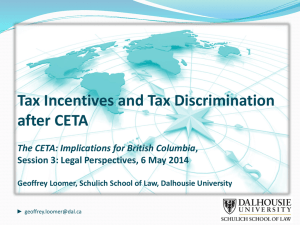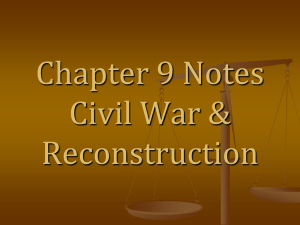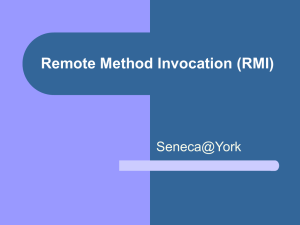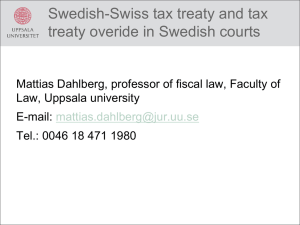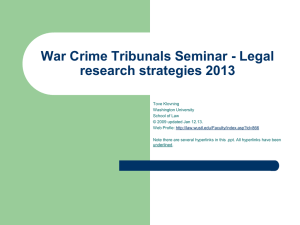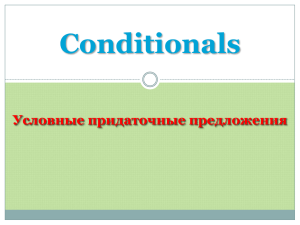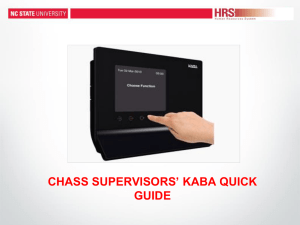Digital Rights Management (DRM)
advertisement
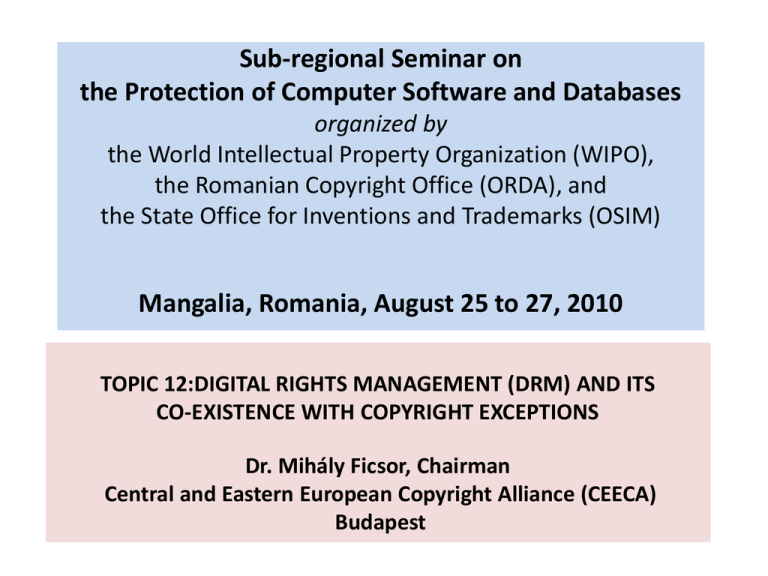
Sub-regional Seminar on the Protection of Computer Software and Databases organized by the World Intellectual Property Organization (WIPO), the Romanian Copyright Office (ORDA), and the State Office for Inventions and Trademarks (OSIM) Mangalia, Romania, August 25 to 27, 2010 TOPIC 12:DIGITAL RIGHTS MANAGEMENT (DRM) AND ITS CO-EXISTENCE WITH COPYRIGHT EXCEPTIONS Dr. Mihály Ficsor, Chairman Central and Eastern European Copyright Alliance (CEECA) Budapest Outline 1. 2. 3. 4. DRM = TPMs and (or) RMI The WIPO „Internet Treaties” on TPMs and RMI No new „access right” Implementation in the EU Information Society (Copyright) Directive 5. Implementation in the C.I.S. Model Copyright Law 6. TPMs and exceptions M. Ficsor, Mangalia, August 25-27, 2010 2 DRM = TPMs and (or) RMI The expression „digital rights management” (DRM) has been introduced and used in professional (legal, technical) jargon, in the press and the media. However, it does not appear in the texts of the provisions of the relevant international treaties (the WIPO Copyright Treaty (WCT) and the WIPO Performances and Phonograms Treaty (WPPT)) in the EU Directives (in particular, in the Information Society (Copyright) Directive) and in the national laws implementing them . „Technological [protection] measures „(TPMs) and „rights management information” (RMI) are the relevant expressions used in the international treaties, the EU Directives and national laws. „DRM” usually means the combination of TPMs and RMI, although in the professional and journalistic discourse it is frequently used also as a reference just to TPMs, and sometimes just to RMI. M. Ficsor, Mangalia, August 25-27, 2010 3 No new „access right” Contrary to certain allegations, no new „access right” emerges as a result of application and protection of TPMs and RMI. Access to works by users have always been controlled; without it, the copyright system simply could not have existed. In book shops, record shops, one has had to pay for copies to get full access; in libraries ,certain rules have had to be respected in order to receive copies in loan; in case of theatrical presentations, concerts, etc., buying tickets or other arrangements have been needed to the members of the public for getting access. M. Ficsor, Mangalia, August 25-27, 2010 4 No new „access right” Even the beneficiaries of exceptions have not been able to get access to copies without any conditions whatsoever. Walking into a bookshop, taking a book from the shelves and walking out without payment referring to the „right” of free quotation? In the digital networked environment, what used to be (i) going to the video shop, (ii) buying a video recording on a cassette; (iii) bringing it home, (iv) putting into the player, (v) sitting down and (vi) pressing the „play” button – has been replaced by a simple click on the keyboard. The use of TPMs („DRM”) is the normal way of making access conditional to the payment of a reasonable price or some other arrangement. M. Ficsor, Mangalia, August 25-27, 2010 5 The WIPO „Internet Treaties” on TPMs and RMI General characterization of the WIPO „Internet Treaties;” adoption, enetering into force and the raticifaction/accession process The WIPO „Internet Treaties” adopted in Geneva on December 21, 1996: the WIPO Copyright Treaty (WCT) entered into force on March 6, 2002 number of Contracting Parties on August 20, 2010: 88 the WIPO Performances and Phonograms Treaty (WPPT) entered into force on May 20, 2002 number of Contracting Parties on August 20, 2010: 86. The Treaties offer overall regulation on copyright and two categories of related rights, but their main objective is to adapt those rights to the digital, networked environment, to the requirements of the information society. M. Ficsor, Mangalia, August 25-27, 2010 6 The WIPO „Internet Treaties” on TPMs and RMI General characterization of the WIPO „Internet Treaties;” „transition countries” party to the Treaties Central and Eastern European countries and the Baltic States that are also members of the EU: all of them are party to the Treaties; that is: Bulgaria, Czech Republic, Estonia, Hungary, Latvia, Lithuania, Poland, Romania, Slovakia and Slovenia. Countries in the West-Balkans: all of them are party to the Treaties: Albania, Bosnia and Herzegovina Croatia, Montenegro, Serbia and the former Yugoslav Republic of Macedonia. New independent countries in Eastern Europe that used to be republics of the former Soviet Union: all of them are party to the Treaties: Belarus, Moldova, the Russian Federation and Ukraine. Countries of the Caucasus region: all of them are party to the Treaties: Armenia, Azerbaijan and Georgia. Central Asian countries: Three of the five countries are party: Kazakhstan, Kyrgyzstan and Tajikistan (however, the latter only to the WCT); the other two – Turkmenistan and Uzbekistan – are not party yet. M. Ficsor, Mangalia, August 25-27, 2010 7 The WIPO „Internet Treaties” on TPMs and RMI General characterization of the WIPO „Internet Treaties; historical and political background No revision of the Berne Convention since the Stockholm (1967)-Paris (1971) twin revisions, in spite of the ever more numerous challenges raised by new technologies. Parallel preparatory work in the Uruguay Round GATT negotiations and in WIPO, with slowing down the latter in order to avoid interference with the former. April 1994: adoption of the WCT package along with the TRIPS Agreement; the latter only bringing about certain modest changes in the substantive copyright and related rights norms. Between the end of 1992 (the de facto closure of the TRIPS negotiations) and 1994: spectacular development and growing use of the Internet. Serious and urgent questions raised for the international copyright and related rights systems as a consequence of this. No chance for reopening the negotiations in WCT; acceleration of the preparatory work in WIPO Committees leading to the adoption of the two “Internet Treaties” within what may have seemed to be a very short time. M. Ficsor, Mangalia, August 25-27, 2010 8 The WIPO „Internet Treaties” on TPMs and RMI General characterization of the WIPO „Internet Treaties;” main features Legally: no revisions of the Berne Convention and the Rome Convention, but “special agreements” (under Berne Article 20 and Rome Article 22). Concerning the level of protection: „Berne & Rome plus TRIPS plus;” that is, what is provided in the Berne and Rome Convention plus what is provided in the substantive provisions of the TRIPS Agreement plus what is still included on the basis of the “digital agenda” of the preparatory work. From the viewpoint of economic and legislative burdens: no real extension of the scope of protection; clarification of the application of the existing norms and, in certain aspects, their adaptation to the new environment, and new means of exercise and enforcement of rights. Politically: the Treaties are well-balanced, flexible and duly take into account the interests of the different groups of countries and stakeholders. M. Ficsor, Mangalia, August 25-27, 2010 9 The WIPO „Internet Treaties” on TPMs and RMI General characterization of the WIPO „Internet Treaties;” the so-called „Berne/Rome plus TRIPS plus” elements included in the WIPO Treaties on the basis of the „digital agenda:” clarification of the application of the right of reproduction in the digital environment, in particular as regards the storage of works, performances and phonograms in electronic memories; recognition/clarification of the existence – as an inevitable corollary to the right or reproduction – of an exclusive right of first distribution of copies of works, fixed performances and phonograms; through a combination and adaptation of existing rights, recognition of the exclusive right of (interactive) making available of works, fixed performances and phonograms; clarification of the application of exceptions and limitations in the new environment; obligations regarding the protection of technological measures and rights management information, as means of exercising and enforcing rights. M. Ficsor, Mangalia, August 25-27, 2010 10 The WIPO „Internet Treaties” on TPMs and RMI Provisions of the „Internet Treaties” on TPMs and RMI Agreement at the 1996 Diplomatic Conference: there was a need for making it possible the application of, and adequately protecting, technological measures (TPMs, such as encryption systems) and rights management information (RMI, such as digital identifiers) in order that copyright and related rights might be exercised and enforced in the digital, networked environment. WCT Article 11 and WPPT Article 18: „Contracting Parties shall provide adequate legal protection and effective legal remedies against the circumvention of effective technological measures that are used by [authors][performers or producers of phonograms] in connection with the exercise of their rights under [this Treaty or the Berne Convention][this Treaty] and that restrict acts, in respect of their [works][performances or phonograms] , which are not authorized by [the [authors][the performers or the producers of phonograms] concerned or permitted by law.” (Emphasis added.) M. Ficsor, Mangalia, August 25-27, 2010 11 The WIPO „Internet Treaties” on TPMs and RMI Provisions of the „Internet Treaties” on TPMs and RMI WCT Article 12 and WPPT Article 19: „(1) Contracting Parties shall provide adequate and effective legal remedies against any person knowingly performing any of the following acts knowing, or with respect to civil remedies having reasonable grounds to know, that it will induce, enable, facilitate or conceal an infringement of any right covered by [this Treaty or the Berne Convention][this Treaty]: (i)to remove or alter any electronic rights management information without authority; (ii) to distribute, import for distribution, broadcast or communicate to the public, without authority, [works] or copies of [works][fixed performances or phonograms] knowing that electronic rights management information has been removed or altered without authority. (Emphasis added; continues.) M. Ficsor, Mangalia, August 25-27, 2010 12 The WIPO „Internet Treaties” on TPMs and RMI Provisions of the „Internet Treaties” on TPMs and RMI WCT Article 12 and WPPT Article 19 (contd.): „(2) As used in this Article, ‘rights management information’ means information which identifies the [work, the author of the work][the performer, the performance of the performer, the producer of the phonogram, the phonogram, the owner of any right in the [work][performance or phonogram], or information about the terms and conditions of use of the [work][performance or phonogram], and any numbers or codes that represents such information, when any of these items of information is attached to a copy of a [work][performance or phonogram] or appears in connection with the communication of [a work][a fixed performance or a phonogram] to the public.” (Emphasis added.) M. Ficsor, Mangalia, August 25-27, 2010 13 Implementation in the EU Information Society (Copyright) Directive The EU Information Society (Copyright) Directive of 2001 (2001/29/EC) is based on the interpretation of the relevant norms of the WCT and the WPPT that the requirement of adequate protection of TPMs can only be duly fulfilled if the protection extends for both „access-control” and „copy-control” TPMs and against both acts of circumvention and „preparatory acts.” This follows not only from the text of the treaty provisions but it is also confirmed by the documents of the negotiating history. The treaty language proposals covered all kinds of TPMs (not only „access controls” or only „copy controls”) and also „preparatory acts” (unauthorized manufacturing and distributing TPM-defeating devices, such as decoders). Since actual circumvention of TPMs usually takes place in places where detection and counter-measures are unrealistic, the obligation to grant „adequate protection” for TPMs may only be fulfilled in the stage of „preparatory acts.” However, it was stressed at the 1996 Diplomatic Conference by some delegations that TPM protection should not be an obstacle to benefit from those copyright exceptions which are important from the viewpoint of public interests. M. Ficsor, Mangalia, August 25-27, 2010 14 Implementation in the EU Information Society (Copyright) Directive Basic TPM provisions of the Directive Article 6(1) and (2) „1. Member States shall provide adequate legal protection against the circumvention of any effective technological measures, which the person concerned carries out in the knowledge, or with reasonable grounds to know, that he or she is pursuing that objective. „2. Member States shall provide adequate legal protection against the manufacture, import, distribution, sale, rental, advertisement for sale or rental, or possession for commercial purposes of devices, products or components or the provision of services which: (a) are promoted, advertised or marketed for the purpose of circumvention of, or (b) have only a limited commercially significant purpose or use other than to circumvent, or (c) are primarily designed, produced, adapted or performed for the purpose of enabling or facilitating the circumvention of, any effective technological measures.” (Emphasis added.) M. Ficsor, Mangalia, August 25-27, 2010 15 Implementation in the EU Information Society (Copyright) Directive Basic RMI provisions of the Directive Article 7 „1. Member States shall provide for adequate legal protection against any person knowingly performing without authority any of the following acts: (a) the removal or alteration of any electronic rights-management information; (b) the distribution, importation for distribution, broadcasting, communication or making available to the public of works or other subject-matter protected under this Directive or under Chapter III of Directive 96/9/EC from which electronic rightsmanagement information has been removed or altered without authority, if such person knows, or has reasonable grounds to know, that by so doing he is inducing, enabling, facilitating or concealing an infringement of any copyright or any rights related to copyright as provided by law, or of the sui generis right provided for in Chapter III of Directive 96/9/EC.” (Emphasis added.) M. Ficsor, Mangalia, August 25-27, 2010 16 Implementation in the C.I.S. Model Copyright Law The „C.I.S. Model Copyright Law” (Model Copyright Law of November 18, 2005, of the Interparliamentary Assembly of States-Participants of the Commonwealth of Independent States) on TPMs. The provisions of the Model Law are based also on the interpretation of the WIPO „Internet Treaties” that all kinds of TPMs (both „access controls” and „copy controls”) and both actual acts of circumvention and „preparatory acts” must be covered: „Article 46 - Статья 46. Ответственность за обход технических средств защиты авторских и смежных прав и за устранение или изменение информации об управлении авторскими и смежными правами 1. За совершение действий, направленных на обход технических средств защиты авторских и смежных прав, наступает такая же ответственность, какая предусмотрена законодательством __________ за нарушение авторских и смежных прав. (Continues.) M. Ficsor, Mangalia, August 25-27, 2010 17 Implementation in the C.I.S. Model Copyright Law The C.I.S. Model Copyright Law on TPMs: „Article 46 - Статья 46. (contd.) Tакая же ответственность наступает за изготовление, импорт, распространение (продажу, представление в прокат), рекламу любого устройства или его компонентов, владение любым устройством или его компонентами для коммерческих целей и предоставление услуг: а) которые рекламируются или предлагаются для продажи в целях обхода технических средств защиты авторских и смежных прав; б) основной целью использования и (или) результатом применения которых является обход любых технических средств защиты авторских и смежных прав; в) которые первоначально предназначены, приспособлены или выполнены с целью предоставления возможности или облегчения обхода технических средств защиты авторских и смежных прав…. . (Emphasis added.) M. Ficsor, Mangalia, August 25-27, 2010 18 Implementation in the C.I.S. Model Copyright Law The C.I.S. Model Copyright Law on RMI Article 46 - Статья 46: „2. Ответственность, установленная абзацем первым пункта 1 настоящей статьи, наступает также за совершение любого из указанных ниже действий, если совершая такие действия лицо знало или должно было знать, что их совершение побуждает, позволяет, способствует или скрывает нарушение авторских или смежных прав: а) устранение или изменение без разрешения информации об управлении авторскими или смежными правами; б) распространение, импорт в целях распространения, публичное сообщение, доведение до всеобщего сведения для интерактивного использования произведений и других объектов, охраняемых настоящим Законом, на которых без разрешения обладателя прав была устранена информация об управлении авторскими или смежными правами.” (Emphasis added.) M. Ficsor, Mangalia, August 25-27, 2010 19 Implementation in the C.I.S. Model Copyright Law The C.I.S. Model Copyright Law on the independence of TPMs - RMI protection from protection against actual acts of infringements The Model Law also contains an important clarification in paragraph 3 of Article 46 (the paragraph 1 and 2 of which contain provisions on TPMs and RMI protection, respectively, as quoted above). It also follows from the of the TPMs - RMI provisions of the WIPO „Internet Treaties” on the basis of their interpretation. Its explicit statement, however, offers a useful guidance, in particular concerning the relationship between protection against unauthorized circumvention of TPMs and protection against infringements of copyright and related rights: „3. Положения настоящей статьи применяются независимо от того, были ли в результате совершения указанных в настоящей статье действий авторские или смежные права нарушены еще каким-либо образом.” In English: „3. The provisions of this article shall be applied irrespective of whether or not, as a result of the activities mentioned in them, authors’ rights or related rights have been infringed in any manner.” M. Ficsor, Mangalia, August 25-27, 2010 20 TPMs and exceptions Provisions of the Information Society (Copyright) Directive Article 6(4) „Notwithstanding the legal protection provided for in paragraph 1, in the absence of voluntary measures taken by rightholders, including agreements between rightholders and other parties concerned, Member States shall take appropriate measures to ensure that rightholders make available to the beneficiary of an exception or limitation provided for in national law in accordance with Article 5(2)(a) [reprographic reproduction], (2)(c) [certain library and educational uses], (2)(d) [ephemeral recording by broadcasters], (2)(e) [copying of broadcasts in social institutions], (3)(a) [illustration for teaching; scientific research], (3)(b) [use by people with disability] or (3)(e) [public security; official procedures] the means of benefiting from that exception or limitation, to the extent necessary to benefit from that exception or limitation and where that beneficiary has legal access to the protected work or subject-matter concerned. (Emphasis added; continues.) M. Ficsor, Mangalia, August 25-27, 2010 21 TPMs and exceptions Provisions of the Information Society (Copyright) Directive Article 6(4) (contd.) „Member State may also take such measures in respect of a beneficiary of an exception or limitation provided for in accordance with Article 5(2)(b) [private copying], unless reproduction for private use has already been made possible by rightholders to the extent necessary to benefit from the exception or limitation concerned and in accordance with the provisions of Article 5(2)(b) and (5) [Article 5(5) subjects the application of all exceptions and limitations to the „three-step test”], without preventing rightholders from adopting adequate measures regarding the number of reproductions in accordance with these provisions… The provisions of the first and second subparagraphs [see the preceding slide and the first paragraph on this slide] shall not apply to works or other subject-matter made available to the public on agreed contractual terms in such a way that members of the public may access them from a place and at a time individually chosen by them.” (Emphasis added.) M. Ficsor, Mangalia, August 25-27, 2010 22 TPMs and exceptions Implementation of the provisons of Article 6(4) Information Society (Copyright) Directive guranteeing the applicability of key public-interest exceptions The majority Member States apply mediation-arbitration systems as such intervention measures. In general, the pessimistic forecasts – according to which the application and protection of TPMs would not guarantee the applicability of important exceptions and limitations – have turned out to be unjustified. An example: In Hungary, the intervention system also takes the form of mediationarbitration, for which the Copyright Experts Council is competent. The system has been in force since May 1, 2004, the day of Hungary’s accession to the European Union. The number of disputes brought in front of the Council during the more than five years, from May 1, 2004 until August 20, 2010 (the completion of this ppt presentation ), because beneficiaries have been unable to get access to works and objects of related rights in order to take advantage of exceptions and limitations, is: M. Ficsor, Mangalia, August 25-27, 2010 23 0 (ZERO) M. Ficsor, Mangalia, August 25-27, 2010 24 TPMs and exceptions Another example: the US system (where there are three catagories of exceptions to the prohibitions concerning technological measures) First category: section 1201(e) for law enforcement, intelligence and other governmental activities. It is applicable to the entire section 1201, while the other exceptions only cover „access control” TPMs. Second category; six specific exceptions concerning „access control” (i) for nonprofit libraries, archives and educational institutions to circumvent access control TPMs solely for the purpose of making a good faith determination as to whether they wish to obtain authorized access to the works concerned (section 1201(d)); (ii) for “reverse engineering” (section 1201(f)); (iii) for encryption research (section 1201(g)); (iv) for the protection of minors (section 1201(h)); (v) for the protection of personal privacy permitting circumvention when the technological measure, or the work it protects, is capable of collecting or disseminating personally identifiable information about the online activities of a natural person (section 1201(i)); and (vi) for security testing (section 1201 (j)). M. Ficsor, Mangalia, August 25-27, 2010 25 TPMs and exceptions The US system Third category of exceptions to TPM prohibitions : The provisions of Section 1201(a)(1)(B)-(E) establish an administrative rule-making procedure to evaluate the impact of the prohibition against the act of circumventing such „access-control” measures. That prohibition only entered into force on 28 October 2000; two years after the enactment of the Digital Millennium Copyright Act (DMCA) implementing the WIPO „Internet Treaties” in the US . From the moment of its application, however, it is subject to possible exceptions for users of works that are in a particular class of works if they are, or are likely to be, adversely affected by virtue of the prohibition in making non-infringing uses. The applicability of such exception is determined through a periodic rulemaking by the Librarian of Congress, on the recommendation of the Register of Copyrights, who is to consult with the Assistant Secretary of Commerce for Communications and Information. M. Ficsor, Mangalia, August 25-27, 2010 26 TPMs and exceptions The US system Under Section 1201(a)(1)(C), the following criteria should to be taken into account for determining possible exceptions in the rulemaking procedure: (i) the availability for use of works protected by copyright; (ii) the availability for use of works for nonprofit archival, preservation and educational purposes; (iii) the impact that the prohibition on the circumvention of technological measures has on criticism, comment, news reporting, teaching, scholarship or research; (iv) the effect of circumvention of technological measures on the market for or the value of copyrighted works; and (iv) such other factors as the Copyright Office (Librarian) considers appropriate. So far, three rulemaking procedures have been completed: in 2000, 2003, 2006 and 2010. M. Ficsor, Mangalia, August 25-27, 2010 27 TPMs and exceptions The US system Under the recently (July 26) published 2010 list, the following classes of works are exempt from the prohibition against circumvention of „access controls:” (1) Motion pictures on DVDs that are lawfully made and acquired and that are protected by the Content Scrambling System when circumvention is accomplished solely in order to accomplish the incorporation of short portions of motion pictures into new works for the purpose of criticism or comment, and where the person engaging in circumvention believes and has reasonable grounds for believing that circumvention is necessary to fulfill the purpose of the use in the following instances: (i) Educational uses by college and university professors and by college and university film and media studies students; (ii) Documentary filmmaking; (iii) Noncommercial videos (Continues.) M. Ficsor, Mangalia, August 25-27, 2010 28 TPMs and exceptions The US system The 2010 list of exceptions to the prohibition of circumvention of „access controls” (contd. – exceptions also allowing so-called „jailbreaking” of Apple’s iPods) (2) Computer programs that enable wireless telephone handsets to execute software applications, where circumvention is accomplished for the sole purpose of enabling interoperability of such applications, when they have been lawfully obtained, with computer programs on the telephone handset. (3) Computer programs, in the form of firmware or software, that enable used wireless telephone handsets to connect to a wireless telecommunications network, when circumvention is initiated by the owner of the copy of the computer program solely in order to connect to a wireless telecommunications network and access to the network is authorized by the operator of the network. (Continues.) M. Ficsor, Mangalia, August 25-27, 2010 29 TPMs and exceptions The 2010 list of exceptions to the prohibition of circumvention of „access controls” (contd.) (4) Video games accessible on personal computers and protected by technological protection measures that control access to lawfully obtained works, when circumvention is accomplished solely for the purpose of good faith testing for, investigating, or correcting security flaws or vulnerabilities, if: (i) The information derived from the security testing is used primarily to promote the security of the owner or operator of a computer, computer system, or computer network; and (ii) The information derived from the security testing is used or maintained in a manner that does not facilitate copyright infringement or a violation of applicable law. (Continues.) M. Ficsor, Mangalia, August 25-27, 2010 30 TPMs and exceptions The 2010 list of exceptions to the prohibition of circumvention of „access controls” (contd.) (5) Computer programs protected by dongles that prevent access due to malfunction or damage and which are obsolete. A dongle shall be considered obsolete if it is no longer manufactured or if a replacement or repair is no longer reasonably available in the commercial marketplace; and (6) Literary works distributed in ebook format when all existing ebook editions of the work (including digital text editions made available by authorized entities) contain access controls that prevent the enabling either of the book’s read-aloud function or of screen readers that render the text into a specialized format. [Exception for blind or otherwise visually impaired persons.] M. Ficsor, Mangalia, August 25-27, 2010 31 THANK YOU FOR YOUR ATTENTION M. Ficsor, Mangalia, August 25-27, 2010 32
